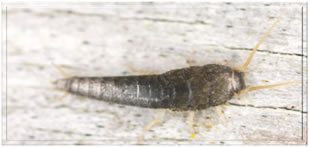
Australian operated

5.0
30 reviews

5.0
30 reviews

Australian operated
Free on-site visit & quote
Over 14,000+ homes protected
5/5 stars is most frequent rating
Silverfish are small, wingless insects often found in Australian homes—particularly in bathrooms, wardrobes, and kitchen cupboards. While they don’t pose a direct health risk, silverfish in house can cause damage to paper, fabrics, and stored goods.
If you are dealing with a silverfish problem, this guide will help you identify them, understand their habits, and explore effective methods for silverfish control—including home remedies for silverfish, expert silverfish treatment options, and tips on how to get rid of silverfish and prevent them in your home.
The most common colour of silverfish is silver, some species can also have slight brown to blue wash through their colour appearance. Their size can rage from 12 to 30mm and their body is shaped like a teardrop. They have 3 bristles with on their rear and two long antennae on the front.

Silverfish in house can survive in all climates but prefer dark or damp areas. Most homeowners find them in shoeboxes, cupboards, sheds, and garages, and even in walk-in wardrobes.
Their diet consists of materials rich in sugars or starch—so if you’re wondering what do silverfish eat, the answer includes glue in books, linen, paper, and silk clothes.
Silverfish reproduction can differ depending on species; some species lay a small amount of eggs per day, maybe 2 to 6. Where other species can lay 4 to 25 eggs. Their eggs are small and oval looking; they are approximately 0.8mm long and taken between 2 to 4 weeks to hatch.
Treating silverfish in house successfully can be difficult, as they are nocturnal and active at night.
Professional silverfish treatment usually involves applying a fine film of dust that contains a small amount of pesticide. This is lightly misted throughout roof voids, under and behind benches and cupboards. This way, it’s almost impossible for silverfish not to come into contact with the dust.
Looking for a silverfish home remedy? Natural silverfish repellents can help keep these unwanted pests away by targeting their dislike for certain scents and environments. Natural options are safe for your family and pets but are most effective when used consistently.
Some of the best natural silverfish repellents include:
These methods will deter silverfish but may not fix the population on silverfish in your home.
Silverfish love moisture and dark spaces, which is why they are frequently found in bathrooms, wardrobes, and kitchen cupboards.
Bathroom: Improve ventilation, dry floors and walls after showers, and use lavender or vinegar spray near corners and drains to repel silverfish naturally.
Wardrobe: Use dried bay leaves or cedar balls inside drawers to deter silverfish. Store seasonal clothes in airtight containers to avoid damage.
Cupboards: Clean pantry shelves regularly and keep food in sealed containers. Place cloves or mothballs in corners where silverfish might hide.
These small adjustments help get rid of silverfish in bathrooms and wardrobes and reduce the risk of recurring infestations.
Silverfish are not dangerous to humans, but they can damage books, clothing, wallpaper, and cardboard boxes. Over time, their feeding habits can cause noticeable material loss in affected areas.
Silverfish are attracted to dark, humid environments and food sources like paper, glue, and fabrics. Leaky pipes, poor ventilation, and cluttered spaces provide ideal conditions for them to thrive.
Yes. Silverfish are nocturnal, meaning they’re most active at night. You may see them scurrying in bathrooms or pantries when the lights are turned on suddenly in the dark.
To get rid of silverfish in Australia, reduce indoor moisture, seal cracks, and remove clutter. Use natural repellents like bay leaves or lavender oil, or contact a licensed pest control expert for targeted treatment.







